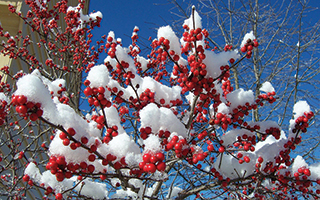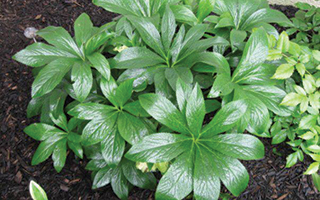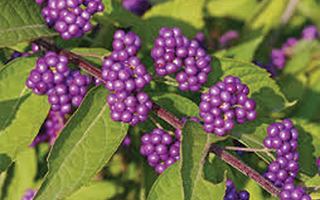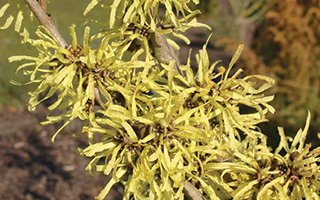 Evergreen plants offer year-round beauty and consistency to your garden. You are likely familiar with evergreen trees and shrubs—but don’t forget evergreen perennials and ground covers for adding lushness to your winter views.
Evergreen plants offer year-round beauty and consistency to your garden. You are likely familiar with evergreen trees and shrubs—but don’t forget evergreen perennials and ground covers for adding lushness to your winter views.
At right, Snow covered Winterberry Holly
Perennials, such as Hellebores, offer evergreen foliage and will flower in late December or early spring to enhance your shade garden. Liriope is a durable evergreen grass—which also comes in a gold-variegated form—blooming a pretty purple shade beginning in late summer.
Now is a perfect time to walk through your home and property, notepad in hand, and assess the gardens from your windows and the views you see regularly around your property in winter. Managers of commercial properties may also take this opportunity to conduct commercial landscape maintenance.
A truly beautiful garden is gorgeous to view all year, not just summer. What are the shortcomings of your landscape? How are the views from your windows right now? These questions apply whether you have a home or an apartment. For example, your apartment patio can become a beautiful garden area with the addition of evergreens in planters. They will provide beauty all year and attract birds. If you live in your own home, then you can easily transform your landscape into anything you dream of, including making more space or changing the entire design with the help of excavation services.
Which garden views do you see the most? The view from the kitchen sink is often overlooked, yet it may be an important view. Dinning rooms seem to be used more in cooler months to celebrate holidays, however the view may lack evergreens. Entrances, porches, and your outdoor patio space are also important. The front foundation of a home is generally best planted with some evergreens for year-round interest.

This assessment is valuable to do both during the growing season and winter. Make visual notes or take pictures to help remember your views. Remember, plants and scenes change with the seasons and that some rooms are used only seasonally. Bear this in mind during a future design phase; for example, a pool patio may not need evergreens. After assessing winter views, prioritize which area is most important, and begin the design process with this area.
With your priority area in mind, what do you like about it and what needs help? What time of day and time of year do you view this area most? What are the site characteristics? Where is the sun in this area throughout the day? What are the soil conditions? Is the site steep or rocky? Are there deer which may browse your plantings? Are there other environmental concerns? Do you wish to attract birds for additional winter interest? Remember the sun is much lower in the sky in winter and may bring welcome light into rooms during those months. Review your likes and dislikes of this space—can pruning or removing plants help to solve problems? Maybe a heated birdbath or birdfeeder would improve the view, creating a focal point from the breakfast table.

Now the design phase begins: Once you have listed assets and liabilities, begin brainstorming solutions. Garden books and online sources, such as Houzz, can be helpful. You can also go right here for landscaping ideas. As ideas arise, sketch and list them. Next explore the feasibility of proposed plants. As ideas arise, check your resources to see their USDA zone hardiness for cold tolerance, mature size, growth rate, soil requirements, light, and moisture requirements. This will pay off in a successful design reducing the chance of failed plants.
A beautiful winter landscape often has at least 30% evergreens. Have fun exploring the multitude of textures and colors available in evergreen plants from the bluish Japanese white pine to the gold false cypress. Some of these bold evergreens are also deer tolerant — an important consideration. Visiting one of our regions illustrious botanical gardens, such as New York Botanical Garden in the Bronx, Wave Hill Garden in the Bronx, or Brooklyn Botanical Garden will educate and inspire even in winter!

Winter fruit-bearing plants such as Winterberry Holly (Ilex verticillata) or Beautyberry (Callicarpa) offer great color in a winter garden. Textured and exfoliating barks such as River Birch (Betula nigra), Paperbark Maple (Acer griseum) and Stewartia also provide great winter interest.
Perennials and ornamental grasses can perform beautifully all year offering color, texture, and decorative seed heads. Consider leaving your perennials and grasses standing through winter. Perennials mirror the changing weather—catching and displaying the low light on overcast days, creating sublime and mystical scenes on foggy mornings or being coated with hoarfrost.
Masters of this perennial garden genre are James van Sweden, FASLA of Oehme van Sweden landscape architects and Piet Oudolf of the Netherlands. Van Sweden was a founder of the New American garden movement introducing flowing, exuberant perennial plantings and the wide use of ornamental grasses to the North American gardener. Oudulf continues to innovate in his perennial garden designs such as the High Line Park in Manhattan and many others. Both designers are widely published and can offer you inspiration.
After you have narrowed down your design solution, consult an expert in landscape design Melbourne to make sure you are on track. Landscape design professionals can be consulted, better nurseries have knowledgeable staff to assist in plant selection, botanical gardens and cooperative extensions—such as Cornell, Rutgers and University of Connecticut—offer information. This important step will reduce the chance of investing in plants that fail.
Now that you have selected “the right plant for the right place,” and you have referenced the mature size of the plant, you can measure the site, estimate the proper location for planting, and calculate the quantity you will need. Planting and design are often full of compromises—armed with the knowledge of plant size and characteristics, you can make the best-educated design decisions. A hawthorn tree’s red winter berries will attract birds and look lovely near your kitchen window in winter. You may wonder, “It will eventually become 25-feet wide, can it still be planted 12 feet from my house?” With adequate sunlight and professional tree services, this medium-sized tree can thrive in this location. This is a fair compromise.
Spring is the favorite planting time before the heat of July and August arrive. Fall is also a great time for all planting—trees and shrubs can be planted through late fall provided the ground is not frozen. Transplanting and dividing perennials is best done during the spring or early fall. New plantings will need to be watered for the first year and during droughts thereafter.
Have fun with your winter landscape-design planning. Spring will be here before you know it!
King Garden Designs specializes in landscape architectural design and installation; masonry; tree work; and expert hand pruning. Information and reviews on: Facebook, Yelp, and Houzz. Contact King Garden Designs at 914-907-0246 or charlessadler@hotmail.com.






